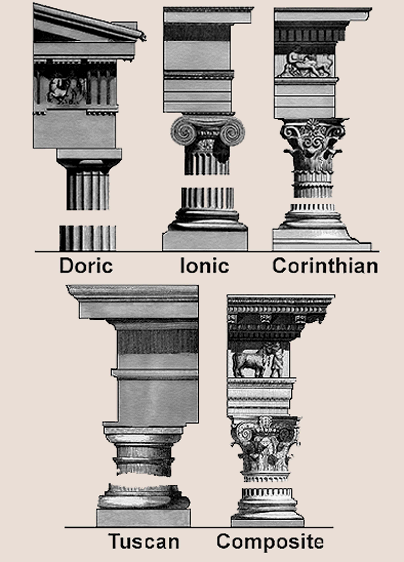The Orders
OVERVIEW
Definition of the Orders
The orders are the basic components in Classical architecture. They are comprised of columns and entablatures, which have standard parts and proportions.
Types of Orders
The Greeks utilized three distinct forms: Doric, Ionic, and Corinthian. The Romans developed their own versions of each and added two additional orders, the Tuscan order and the Composite order, which gave them a total of five orders.
Distinguishing the Types
Although the entablature is also distinctive, the column, especially its capital, is the most recognizable guide to distinguishing the orders.
Columns vary in proportion, with the Doric column being the thickest and the Corinthian the most slender.
Capital
The Doric capital, the simplest of the Greek capitals, consists of a square slab called an abacus, a circular cushion-like form called an echinus, and a fluted band called the necking.
Shaft
The shaft is fluted, carved with adjacent vertical grooves whose borders form a series of pointed edges. The number of flutes was usually twenty.
The shaft rests directly on the floor without a base. (The Roman version has a base.)
Frieze
The frieze consists of an alternation of triglyphs, blocks having vertical channels, and metopes, blocks that may be plain or carved in relief.
Evolution
The Doric order is considered to be the oldest of the orders.
In the evolution of Greek architecture, earlier Doric columns had wider capitals, more pronounced entasis, and more massive proportions than later Doric columns.
Because the Romans preferred the more ornamental orders, free-standing Doric columns were uncommon in Roman architecture.
IONIC ORDER
Capital
The Ionic capital is distinguished by a scroll whose volutes (spirals) are usually parallel to the building plane
Because the scrolls of Ionic capitals create distinct frontal and side facings, it is necessary to make adjustments to the corner columns so that adjacent facings match.
At the Erechtheion, the Greeks solved the problem by creating corner columns with frontal scrolls on both facings. This form was also continued by the Romans.
The Greeks invented a second solution in the fourth century BC in which the scrolls radiated out from the center, giving the capital four matching facings. This was adopted by the Romans, who also used radiating volutes when they developed the Composite order.
Shaft
The flutes are narrower, usually 24 per column, and the channels do not touch.
Base
Unlike the Doric order, the columns of the Ionic order rest on bases made up of circular moldings resting on a low square plinth. Their round over square forms make a visual transition from the cylindrical shaft to the flat floor. Variations of this form were used for the other orders as well.
Frieze
The frieze is a continuous band that may be plain or carved.
CORINTHIAN ORDER
Capital
The Corinthian capital is taller than those of the Doric and Ionic orders. It is carved with two rows of acanthus leaves, which are interspersed with small volutes at the top.
Shaft
The shaft may be fluted or unfluted.
Entablature
The entablature is similar to that of the Ionic order, and the frieze may be decorated or plain.
History
The Corinthian order was the last of the Greek orders to be developed. The earliest known example of its exterior use is the Monument of Lysicrates in Athens, which dates to 334 BC.
The Corinthian order was widely used in Roman architecture.
History
The Tuscan Order was developed by the Etruscans, an ancient people who flourished in Italy before the rise of Roman civilization. (The name "Tuscan" is derived from Tuscany, the Italian region around Florence, Siena, and Pisa.)
Comparison with the Doric Order
This order is similar to the Doric but simpler in lacking fluting, triglyphs, and metopes. It also has a base. Among the Roman orders, Tuscan columns have the greatest entasis.
Capital
The Composite order unites the prominent volutes of the Ionic order with the two rows of acanthus leaves of the Corinthian.
Its entablature follows that of the Corinthian order.
History
The Composite order was invented by the Romans and first used on the Arch of Titus. This order was widely used by the second century AD, and it remained popular for the rest of Roman history.




 Add Placemark
Add Placemark Go Back
Go Back 




